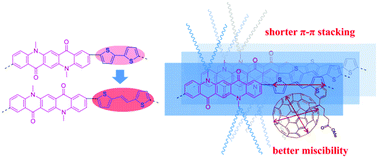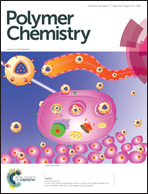High performance quinacridone-based polymers in film transistors and photovoltaics: effects of vinylene linkage on crystallinity and morphology†
Abstract
A novel quinacridone-based polymer containing a vinylene linkage, PQTE, was synthesized and exhibited higher performance both in organic thin-film transistors and solar cells than that of the reference polymer PQ2T. On introducing the vinylene linkage, a strong interchain interaction is obtained with a short π–π stacking distance of 3.49 Å in the polymer PQTE, which is responsible for the highest mobility of 0.67 cm2 V−1 s−1 reported to date for quinacridone-based semiconductors. More significantly, the incorporation of a thienylene–vinylene–thienylene unit contributes to good miscibility between PQTE and PC71BM. Because of the effective intercalation of PC71BM in the PQTE lamellar structure, a high power conversion efficiency of 3.9% was achieved without any additives or post-treatments. Our rational molecular design qualifies quinacridone as a promising building block simultaneously in high performance polymer thin-film transistors and solar cells.


 Please wait while we load your content...
Please wait while we load your content...